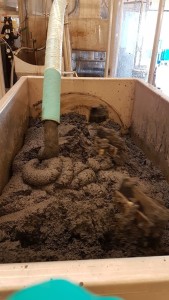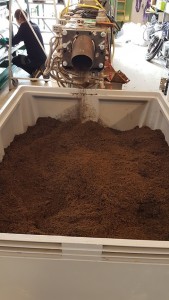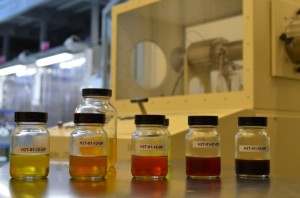The mitigation of climate change requires a rapid phase-out of fossil fuels in all sectors of the economy. The specific need to supply large amounts of transportation fuels via next generation biofuel technologies has been outlined also by the European Commission. The HyFlexFuel consortium addresses this challenge by demonstrating all individual process steps along a hydrothermal liquefaction pathway that converts various types of organic feedstock to transportation fuels. Hydrothermal liquefaction has in fact the potential to produce renewable fuels with low environmental impact at tolerable cost.
The progress achieved by HyFlexFuel, four further EU H2020 projects (Heat-to-Fuel, NextGenRoadFuels, 4REFINERY, WASTE2ROAD) and the Norwegian National FME Centre Bio4Fuels will be presented at a joint Expert workshop on “Potential of Hydrothermal Liquefaction (HTL) routes for biofuel production” on 19th November, 2019, in Brussels, Belgium. The complete and entire project’s title is “HyFlexFuel: Hydrothermal liquefaction: Enhanced performance and feedstock flexibility for efficient biofuel production”.
Project overview and Consortium partners
A project overview of HyFlexFuel was discussed in more detail in a preceding online-article.
The project implementation involves the continuous hydrothermal processing of representative model feedstocks such as sewage sludge, microalgae (spirulina), and cellulosic biomass (miscanthus) at Aarhus Universitet. The resulting biocrude samples are further upgraded to transportation fuels at Aalborg Universitet with the support of Haldor Topøe AS, while Eni S.p.A investigates a potential co-processing of HTL biocrudes in existing refineries. The aqueous phase samples, which are separated from the biocrudes after hydrothermal liquefaction, contain valuable nutrients and remaining organic material. The energetic valorization of the organic content via catalytic hydrothermal gasification is investigated at the Paul Scherrer Institut, while nutrients are recovered at the Universität Hohenheim in form of magnesium ammonium phosphate (struvite). An alternative way of energetic valorization in form of anaerobic digestion is tested at OWS nv. The experimental demonstrations of all major project steps are accompanied by an analysis of feedstock potentials by Deutsches Biomasseforschungszentrum and further system analyses led by the project coordinator Bauhaus Luftfahrt e.V., with a special emphasis on the environmental performance and the economic viability of the final transportation fuel products.
First results with the largest pilit-scale HTL reactor
The HyFlexFuel project enters the second half of a four-year project duration in October 2019. The result from the early phase of the project can be retrieved from the media centre of the HyFlexFuel website.
These results stem from the initial biocrude production campaigns with the unique pilot plant for continuous hydrothermal liquefaction at Aarhus Universitet [1], the chemical analysis of the resulting biocrude samples [2] and initial upgrading of biocrudes in batch experiments [3,4]. The pilot plant is capable to process a feed capacity of up to 100 liters of slurry per hour at temperatures of about 350°C and pressures around 200 bars (subcritical regime). To our knowledge this is the largest pilot-scale HTL reactor reported in peer reviewed literature. Continuous experimental campaigns were run with miscanthus, sewage sludge and spirulina. A heat recovery rate of 80% has been achieved by inducing an oscillatory motion of the slurry, average yields were 26.2 wt%, 32.9 wt% and 24.5 wt% respectively from miscanthus, spirulina and sewage sludge. The corresponding chemical energy recovery in the biocrudes was 48.1%, 46.8% and 33.6% [1]. The chemical analysis of HTL crudes shows feedstock characteristic differences in the composition, which translate into subtle differences during catalytic upgrading of HTL crudes, and finally into differences in the molecular compositions of the upgraded fuel products.
The processing of sewage sludge tended to produce n-alkanes, which is promising for diesel or jet fuel production, while the processing of miscanthus, as a lignocellulosic model feedstock, yielded a large fraction of gasoline-range product with high aromatic content. These initial results indicate the feasibility to produce liquid transportation fuels such as gasoline, jet fuel and diesel via hydrothermal liquefaction. These results also indicate that hydrothermal liquefaction of different feedstock involves an adaption of processing conditions and yields a specific distribution of final products.
The initial results from the valorization of the aqueous phase and the HyFlexFuel system analyses were presented at the European Biomass Conference and Exhibition (EUBCE) 2019 in Lisbon, including a successful demonstration of both, methane production via catalytic hydrothermal gasification, and phosphate recovery from HTL process water.
HyFlexFuel: how to develop hydrothermal liquefaction towards a sustainable and economically attractive biofuel technology
The initial results from HyFlexFuel show the feasibility to produce biofuels from various organic feedstock via hydrothermal liquefaction. The ability to process a broad range of feedstock opens many opportunities reaching from novel applications within waste management systems to large-scale biofuel production at comparably low environmental impact. The hydrothermal conversion of organic material into viscous biocrudes alters the chemical composition but preserves several feedstock specific characteristics. These feedstock specific characteristics relate to the ash content, the molecular composition of the HTL liquids, the energetic valorization and nutrient recovery from of the aqueous phase, the biocrude upgrading procedures and the suitability to produce specific transportation fuel products.
The HyFlexFuel project develops technological solutions for all individual process steps and contributes to an increased understanding of the involved interplay of feedstock characteristics, fuel conversion technology, and by-product valorization. Thereby, HyFlexFuel contributes to the development of hydrothermal liquefaction towards a sustainable and economically attractive biofuel technology.
Discover more about HyFlexFuel at the upcoming HTL workshop
The HyFlexFuel project will participate in the Expert Workshop: Potential of Hydrothermal Liquefaction (HTL) routes for biofuel production on November 19th, 2019 in Brussels with the aim of highlighting the state of art and challenges for this promising conversion technology. The partners will illustrate the status of the current activities and the prospects for industrial uptake of the processes. Signup for the workshop and join us in Brussels.
Info and contacts
HyFlexFuel combines the expertise of ten European partners from academia and industry: Bauhaus Luftfahrt e.V., Aarhus Universitet, Aalborg Universitet, Paul Scherrer Institut, Deutsches Biomasseforschungszentrum, Universität Hohenheim, OWS nv, Eni S.p.A., Haldor Topøe AS, Arttic. The project was kicked off in October 2017 and will be completed in September 2021.
HyFlexFuel has received funding (EUR 5.04 million) from the European Union’s Horizon 2020 research and innovation programme under grant agreement No 764734.
Website: www.hyflexfuel.eu
Twitter account: @HyFlexFuel
References
[1] K. Anastasakis et al, Continuous Hydrothermal Liquefaction of Biomass
in a Novel Pilot Plant with Heat Recovery and Hydraulic Oscillation, Energies, 2018, 11, 2695; doi:10.3390/en11102695
[2] R. B. Madsen et al, Rapid Determination of Water, Total Acid Number, and Phenolic Content in Bio-Crude from Hydrothermal Liquefaction of Biomass using FT-IR, Energy Fuels, 2018, 32, 7, 7660-7669; doi:10.1021/acs.energyfuels.8b01208
[3] M. S. Haider et al, Catalytic Hydrotreatment of Microalgae Biocrude from Continuous Hydrothermal Liquefaction: Heteroatom Removal and Their Distribution in Distillation Cuts, Energies, 2018, 11, 3360; doi:10.3390/en11123360
[4] D. Castello et al, Catalytic upgrading of hydrothermal liquefaction biocrudes: Different challenges for different feedstocks, Renewable Energy, 2019, 141, 420-430; doi:10.1016/j.renene.2019.04.003.
Picture Material
Sewage sludge feedstock slurry with 17% dry matter from HTL processsing
Digestate from anaerobic digestion after concentration with a screw press and subsequent size reduction using a twin screw extruder for HTL slurry preparation
Samples of catalytically upgraded biocrudes from microalga Spirulina obtained at different reaction conditions
Text and figures by the HyFlexFuel consortium





